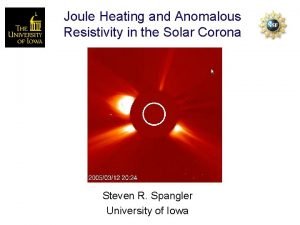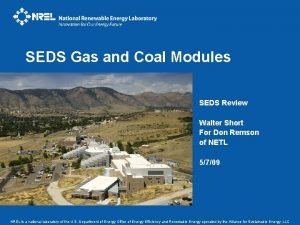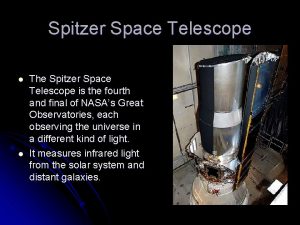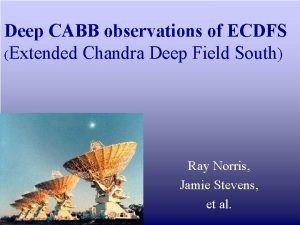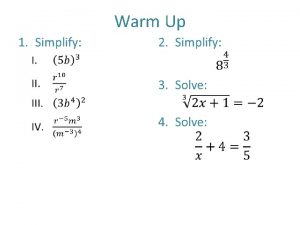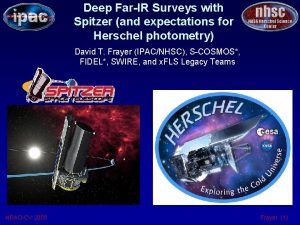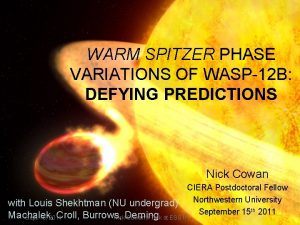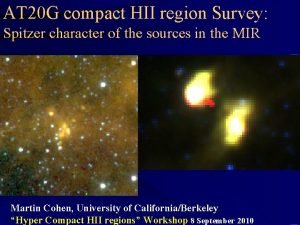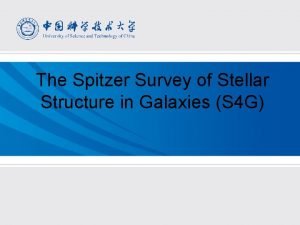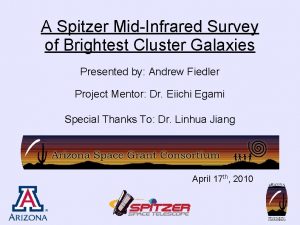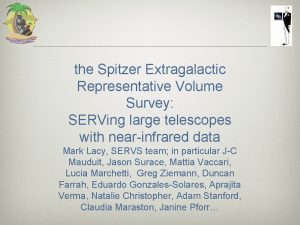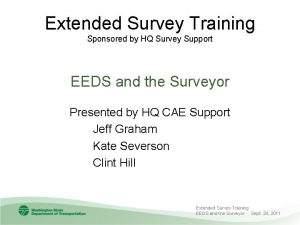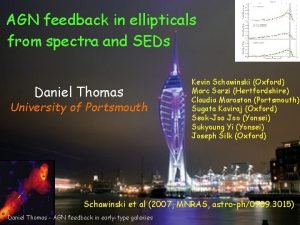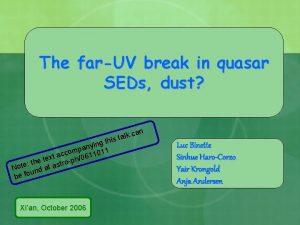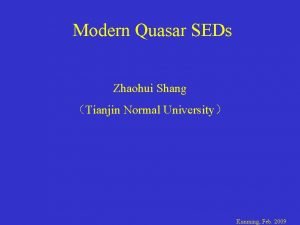The Spitzer Extended Deep Survey SEDS Spitzer Warm


























- Slides: 26

The Spitzer Extended Deep Survey (SEDS) Spitzer Warm Mission Kai Noeske, Giovanni G. Fazio Harvard-Smithsonian Center for Astrophysics and the SEDS Team The Origin of Galaxies: Lessons from the Distant Universe Obergurgl, Austria, 16 Dec 2009

SEDS: The Spitzer Extended Deep Survey - Overview • PI: Giovanni Fazio, Cf. A – 47 Co-I’s from 23 institutions • Primary Scientific Objective – Galaxy formation in the early Universe – First complete census of the assembly of stellar mass and black holes as a function of cosmic time back to the era of reionization – Series of secondary objectives • Unbiased survey at 3. 6 and 4. 5 microns – 12 hours/pointing ([3. 6] = 26 AB, 5 σ) – five well-studied fields (0. 9 sq deg) • 10 times area of deep GOODS survey • Total Time: 2108 hrs over 1. 5 years • No proprietary time on data

SEDS Co-Investigators Harvard-Smithsonian Cf. A: University of Chicago/KICP: Brant Robertson Lars Hernquist, Matt Ashby, Jiasheng Huang, Kai Noeske, Steve Willner, Stijn Wuyts, T. J. Cox, Yuexing Li, Kamson Lai Swinburne University: Darren Croton Max-Planck-Institut für Astronomie: University of Florida, Gainesville: Vicki Sarajedini Hans-Walter Rix, Eric Bell, Arjen van der Wel Astrophysikalisches Institut, Potsdam: University of Califronia, Santa Cruz: Andrea Cattaneo Sandy Faber, David Koo, Raja Guhathakurta, Garth Illingworth, Rychard Bouwens University of Massachusetts, Amherst: NASA/GSFC: Royal Observatory Edinburgh: Sasha Kashlinsky, Rick Arendt, John Mather, Harvey Moseley James Dunlop Carnegie Observatories: Haojin Yan, Ivo Labbe, Masami Ouchi University of Pittsburgh: Jeff Newman Stanford University/KIPAC: Risa Wechsler Hojun Mo Institute of Astronomy and Astrophysics, Academia Sinica, Taiwan: Lihwai Lin National Research Council, Herzberg Institute of Astrophysics: Luc Simard Space Telescope Science Institute: Anton Koekemoer Texas A&M University: Casey Papovich University of Arizona: Ben Weiner, Romeel Dave, Kristian Finlator, Eiichi Egami University of Western Ontario: Pauline Barmby Imperial College, London: Kirpal Nandra Tohoku University, Japan: Toru Yamada Oxford University: Dimitra Rigopoulou University of California, Riverside: Gillian Wilson

SEDS: The Spitzer Extended Deep Survey - Motivation • Only Spitzer can see redward of 4000 A break at high z => stellar masses/populations, photo-zs • Warm Mission only chance to deeply map large area at >3 microns => comprehensive census of: –stellar mass assembly in the early universe (L* at z=6) –high-z AGN –star formation into era of reionization • Best target finder for JWST, ALMA, ELTs, large radio arrays

SEDS: Technical Aspects • Sensitivity – 12 hrs/pointing at 3. 6 and 4. 5 microns – [3. 6] = 26 AB, 5 σ (0. 15 μJy) – Robustly measure M* (5 x 109 Msun) at z=6 • Field Geometry and Configuration – Clustering and large scale structure: fields > 20 - 30 arcmin – (>3 -4 x correlation length of massive galaxies at z=6) • Number of Fields – Cosmic variance: 5 fields • Field Selection • – Fields with deep auxiliary data: Extended GOODS-S, Extended GOODS-N, UDS, EGS, COSMOS/Ultra. Vista 3 Epochs, 6 months apart -> variability

Expected Cumulative Number Density at z = 6 Ivo Labbe & Haojing Yan

SEDS: Technical Aspects • Sensitivity – 12 hrs/pointing at 3. 6 and 4. 5 microns – [3. 6] = 26 AB, 5 σ (0. 15 μJy) – Robustly measure M* (5 x 109 Msun) at z=6 • Field Geometry and Configuration – Clustering and large scale structure: fields > 20 - 30 arcmin – (>3 -4 x correlation length of massive galaxies at z=6) • Number of Fields – Cosmic variance: 5 fields • Field Selection • – Fields with deep auxiliary data: Extended GOODS-S, Extended GOODS-N, UDS, EGS, COSMOS/Ultra. Vista 3 Epochs, 6 months apart -> variability

SEDS: Technical Aspects • Sensitivity – 12 hrs/pointing at 3. 6 and 4. 5 microns – [3. 6] = 26 AB, 5 σ (0. 15 μJy) – Robustly measure M* (5 x 109 Msun) at z=6 • Field Geometry and Configuration – Clustering and large scale structure: fields > 20 - 30 arcmin – (>3 -4 x correlation length of massive galaxies at z=6) • Number of Fields – Cosmic variance: 5 fields • Field Selection • – Fields with deep auxiliary data: Extended GOODS-S, Extended GOODS-N, UDS, EGS, COSMOS/Ultra. Vista 3 Epochs, 6 months apart -> variability

IMPACT OF COSMIC VARIANCE (Bright i′ -drops in four 1 deg 2 CFHTLS; Haojing Yan) D 1(2 h, -4 d)) D 2 (10 h, +2 d) (w/COSMOS) D 4(22 h, -18 d) D 3(14 h, +53 d) (overlap EGS)) 16. 5’x 10’ GOODSSize Area D 1: D 2: D 3: D 4 ~ 1. 2: 1. 7: 1. 0: 1. 8

SEDS: Technical Aspects • Sensitivity – 12 hrs/pointing at 3. 6 and 4. 5 microns – [3. 6] = 26 AB, 5 σ (0. 15 μJy) – Robustly measure M* (5 x 109 Msun) at z=6 • Field Geometry and Configuration – Clustering and large scale structure: fields > 20 - 30 arcmin – (>3 -4 x correlation length of massive galaxies at z=6) • Number of Fields – Cosmic variance: 5 fields • Field Selection • – Fields with deep auxiliary data – spread in RA (scheduling), DEC (northern, southern terrestrial facilities) 3 Epochs, 6 months apart -> variability

SEDS Survey Fields

SEDS: Technical Aspects • Sensitivity – 12 hrs/pointing at 3. 6 and 4. 5 microns – [3. 6] = 26 AB, 5 σ (0. 15 μJy) – Robustly measure M* (5 x 109 Msun) at z=6 • Field Geometry and Configuration – Clustering and large scale structure: fields > 20 - 30 arcmin – (>3 -4 x correlation length of massive galaxies at z=6) • Number of Fields – Cosmic variance: 5 fields • Field Selection • – Fields with deep auxiliary data: Extended GOODS-S, Extended GOODS-N, UDS, EGS, COSMOS/Ultra. Vista 3 Epochs, 6 months apart -> variability

SEDS: Technical Aspects • Expected Number of Sources – Sufficient to derive mass functions and perform clustering studies – Finlator models: • 8000, 2000, and 200 galaxies at z = 5, 6, and 7 • few at z ~ 9. • Source Selection – Initially: Conventional Lyman dropout technique • Z = 4, 5, 6, and 7: B, V, i, and z – Full photo-zs for sample: require matching YJHK data (~26 AB) : Ultra. VISTA in COSMOS, UKIDSS UDS, 5 yrs – To unlock full potential (depth, de-blending): WFC 3!!!

Area Coverage vs Exposure Time

SEDS: Scientific Objectives • Galaxy Assembly in the Early Universe – Direct study of the mass assembly back to the era of reionization. • Study stellar masses and mass functions from z = 4 - 6 • Constrain high mass end of mass function at z = 7. – Measurement of spatial clustering of galaxies • Determine the evolution of galaxy properties as a function of halo masses. – Study identified Lyα emitters at z = 5 - 7: stellar masses, stellar populations • High z counterparts to dwarf galaxies? • Different sample compared to dropouts – Black hole evolution at z > 6. • High-z AGN number counts (constrain evolutionary models) • IRAC essential for high-z obscured AGN (z>6: ~100 expected) • Relationship to stellar growth – Tests of theoretical models of galaxy assembly

SED of an i’ droput Galaxy at z = 6. 6 M. Ouchi et al. 2008

SEDS: Scientific Objectives • Galaxy Assembly in the Early Universe – Direct study of the mass assembly back to the era of reionization. • Study stellar masses and mass functions from z = 4 - 6 • Constrain high mass end of mass function at z = 7. – Measurement of spatial clustering of galaxies • Determine the evolution of galaxy properties as a function of halo masses. – Study identified Lyα emitters at z = 5 - 7: stellar masses, stellar populations • High z counterparts to dwarf galaxies? • Different sample compared to dropouts – Black hole evolution at z > 6. • High-z AGN number counts (constrain evolutionary models) • IRAC essential for high-z obscured AGN (z>6: ~100 expected) • Relationship to stellar growth – Tests of theoretical models of galaxy assembly

Observed SF histories to z~6, test of galaxy models z=7 Evol. of Galaxy Main Sequence Noeske+07 Labbe+09 z=6 Marchesini+09 wait for SEDS • Test of Galaxy Formation Observed SF History vs Stellar Mass Models • Understand Physics of SF • Reionization z=8 z=6 Dave, Finlator & Oppenheimer 06 Evol. of Stellar Mass Functions Clustering, abundances: “Observed” SF History vs Halo Mass Noeske+ 2007 b & 2010, in prep.

SEDS: Scientific Objectives • Auxiliary Science – Galaxy Evolution from z ~ 1 - 4 • Mass assembly of galaxies: improved stellar masses, photo-zs, etc • Emergence of quiescent galaxies (IRAC: quiescent-red vs dust-red) – Mid-infrared Variability for AGN Identification • A more universal AGN tracer: many variable sources not seen in X-ray – Measurement of the Cosmic Infrared Background radiation spatial fluctuations

Nature of Infrared Background Fluctuations High-z protogalaxies or faint foreground objects?

Project Status, Schedule • Warm IRAC performs well • First epoch (4 h/pointing) UDS observed • Next up: COSMOS/Ultra. VISTA, EGS • Total duration: 18 months • No proprietary period on raw data • After end of observations: release of reduced mosaics, source catalogs

Warm IRAC Performance: Comparable to Cryogenic Warm 3. 6 μm Cryo 3. 6 μm Warm 4. 5 μm Cryo 4. 5 μm

UDS, Ch 1, 4 h AORs: S. Willner Reduction: M. Ashby

5 UDS Field (20 x 20 arcmin) 3. 6 micron 4. 5 micron AORs: S. Willner, Reduction: M. Ashby

UDS Field (5 x 5 arcmin) 3. 6 micron 4. 5 micron Frequent worry for deep IRAC exposures: Confusion But: 2/3 of sources are unconfused

Summary: • • Spitzer Warm Mission Exploration Science Program, PI: G. Fazio Unbiased survey at 3. 6 and 4. 5 microns, 0. 9 deg 2 (10 x GOODS) 12 h/pointing, [3. 6] = 26 AB, 5 σ (0. 15 μJy), 2108 hours total Five fields with excellent ancillary data: – E-GOODS-N, E-CDFS, EGS, UDS, COSMOS/Ultra. VISTA • Science: – First census of galaxy assembly at high z, out to reionization: • • Stellar mass functions, L* at z=6, high mass end at z=7 Black hole growth at z>6 Clustering -> Galaxy properties as fct. of Halo Mass Star formation histories to z=6 Test and improvement of galaxy and reionization models Nature of LAEs – z=1 -4 galaxies: photo-zs, stellar populations – Nature of IR BG fluctuations Observations underway, 2 epochs, 18 months total, no proprietary period on data Pathfinder for JWST, ALMA, ELTs, radio arrays One of a kind chance to understand the early Universe, very lucky this
 Joule solar problems
Joule solar problems Primary deviance definition
Primary deviance definition Kurt spitzer
Kurt spitzer Deep asleep deep asleep it lies
Deep asleep deep asleep it lies Deep forest: towards an alternative to deep neural networks
Deep forest: towards an alternative to deep neural networks 深哉深哉耶穌的愛
深哉深哉耶穌的愛 Ample abcde
Ample abcde Dot
Dot Bổ thể
Bổ thể Vẽ hình chiếu đứng bằng cạnh của vật thể
Vẽ hình chiếu đứng bằng cạnh của vật thể Thế nào là sự mỏi cơ
Thế nào là sự mỏi cơ Phản ứng thế ankan
Phản ứng thế ankan Sự nuôi và dạy con của hổ
Sự nuôi và dạy con của hổ Thiếu nhi thế giới liên hoan
Thiếu nhi thế giới liên hoan Chúa yêu trần thế alleluia
Chúa yêu trần thế alleluia điện thế nghỉ
điện thế nghỉ Một số thể thơ truyền thống
Một số thể thơ truyền thống Trời xanh đây là của chúng ta thể thơ
Trời xanh đây là của chúng ta thể thơ Các số nguyên tố là gì
Các số nguyên tố là gì Tỉ lệ cơ thể trẻ em
Tỉ lệ cơ thể trẻ em Tia chieu sa te
Tia chieu sa te đặc điểm cơ thể của người tối cổ
đặc điểm cơ thể của người tối cổ Các châu lục và đại dương trên thế giới
Các châu lục và đại dương trên thế giới Thế nào là hệ số cao nhất
Thế nào là hệ số cao nhất Hệ hô hấp
Hệ hô hấp ưu thế lai là gì
ưu thế lai là gì Các môn thể thao bắt đầu bằng từ đua
Các môn thể thao bắt đầu bằng từ đua
